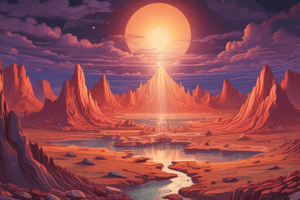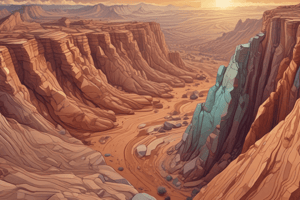Podcast
Questions and Answers
Which layer of the Earth is also known as the lithosphere?
Which layer of the Earth is also known as the lithosphere?
Crust
What are the two main types of the Earth's crust?
What are the two main types of the Earth's crust?
Continental crust and Oceanic crust
What is the primary composition of the Earth's mantle?
What is the primary composition of the Earth's mantle?
Silicon, iron, and magnesium
What characteristic distinguishes the outer core from the inner core?
What characteristic distinguishes the outer core from the inner core?
What temperature range is characteristic of the mantle?
What temperature range is characteristic of the mantle?
What is the main difference between rocks and minerals in the Earth's crust?
What is the main difference between rocks and minerals in the Earth's crust?
What type of rocks can transform into metamorphic rocks under intense temperature and pressure?
What type of rocks can transform into metamorphic rocks under intense temperature and pressure?
Which process causes magma to form igneous rocks?
Which process causes magma to form igneous rocks?
How are sedimentary rocks formed from igneous rocks?
How are sedimentary rocks formed from igneous rocks?
What are the properties of metamorphic rocks?
What are the properties of metamorphic rocks?
Identify the rock type for marble.
Identify the rock type for marble.
What happens to metamorphic and sedimentary rocks under extreme temperature and pressure?
What happens to metamorphic and sedimentary rocks under extreme temperature and pressure?
What are the three main types of rocks?
What are the three main types of rocks?
What is the barysphere and what is its average thickness?
What is the barysphere and what is its average thickness?
What are the two layers of the core?
What are the two layers of the core?
What state does the outer core maintain, and what is it made of?
What state does the outer core maintain, and what is it made of?
Despite being hotter, why does the inner core maintain its solid state?
Despite being hotter, why does the inner core maintain its solid state?
What constitutes the lithosphere?
What constitutes the lithosphere?
What are the two kinds of igneous rocks?
What are the two kinds of igneous rocks?
From which Latin word does 'igneous' originate and what does it mean?
From which Latin word does 'igneous' originate and what does it mean?
How are sedimentary rocks formed?
How are sedimentary rocks formed?
What are the characteristics of intrusive igneous rocks?
What are the characteristics of intrusive igneous rocks?
Name two examples of extrusive igneous rocks.
Name two examples of extrusive igneous rocks.
Where are sedimentary rocks generally formed?
Where are sedimentary rocks generally formed?
What makes igneous rocks water-resistant?
What makes igneous rocks water-resistant?
Why are sedimentary rocks also known as stratified rocks?
Why are sedimentary rocks also known as stratified rocks?
What causes metamorphic rocks to form from pre-existing rocks?
What causes metamorphic rocks to form from pre-existing rocks?
Name two examples of metamorphic rocks and the original rocks from which they formed.
Name two examples of metamorphic rocks and the original rocks from which they formed.
List two characteristics of metamorphic rocks.
List two characteristics of metamorphic rocks.
Explain the term 'rock cycle'.
Explain the term 'rock cycle'.
How are igneous rocks formed?
How are igneous rocks formed?
What happens to sedimentary and igneous rocks under intense heat and pressure?
What happens to sedimentary and igneous rocks under intense heat and pressure?
What transformation process turns coal into graphite?
What transformation process turns coal into graphite?
Why do metamorphic rocks not have empty spaces between them?
Why do metamorphic rocks not have empty spaces between them?
Flashcards are hidden until you start studying
Study Notes
Layers of the Earth
- The Earth is made up of three layers: Crust, Mantle, and Core.
- Crust:
- The outermost layer of the Earth
- Also called the lithosphere
- Thin compared to the other layers
- Divided into two parts: Continental crust and Oceanic crust
- Continental crust is made of silica and aluminum
- Oceanic crust is made of silica and magnesium
- Mantle:
- The middle layer of the Earth
- Also called the mesosphere
- Ranges from 870°C to 2,200°C, with a density of 3.5 to 5.5 g/cm³
- Made up of silicon, iron, and magnesium
- Consists of two layers: upper mantle and lower mantle
- Core:
- The innermost layer of the Earth
- Also called the barysphere
- Ranges from 3,000°C to 5,000°C, with a thickness of 3,500 km
- Consists of two layers: outer core and inner core
- The outer core is molten, while the inner core is solid due to extreme pressure
Rocks and Minerals
- The Earth's crust consists of rocks and minerals.
- Rocks are made up of minerals.
- Minerals occur naturally in the Earth's crust and have a definite chemical composition.
- Rocks do not have a chemical composition.
Geology
- Geology is the study of Earth.
- It is the primary earth science that tells us how the Earth was formed, its structure, composition, and the various types of processes acting on it.
- The knowledge of the earth is important as we learn to minimize our risks from earthquakes, volcanoes, slope failures, and damaging storms.
Types of Rocks
- Igneous Rocks:
- Formed as a result of volcanic eruptions
- Made up of silicon, iron, and magnesium
- Two types: intrusive and extrusive
- Characteristics: hard, compact, water-resistant, primary, and a storehouse of minerals
- Sedimentary Rocks:
- Formed from sediments
- Made up of small pieces of rocks formed by the breakdown of existing rocks
- Characteristics: formed in riverbeds, lakebeds, and oceanbeds, layers are well defined
- Metamorphic Rocks:
- Formed when igneous and sedimentary rocks are subjected to intense heat and pressure
- Characteristics: very hard, high specific gravity, no empty spaces, and gems can be found in them
Rock Cycle
- The process of formation of rocks from magma to igneous rocks, sedimentary rocks, and metamorphic rocks, and back to magma again.
- The cycle includes: magma flows out, cools, and solidifies to form igneous rocks, igneous rocks are broken down into sediments, sediments form sedimentary rocks, sedimentary rocks transform into metamorphic rocks, and metamorphic rocks melt under extreme temperature and pressure to form magma again.
Studying That Suits You
Use AI to generate personalized quizzes and flashcards to suit your learning preferences.




